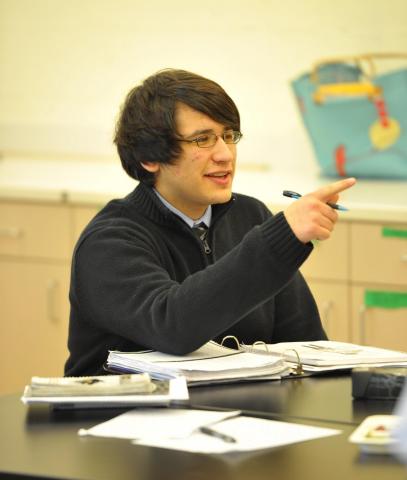A Writing Teacher’s New Year’s Resolution: Re-visioning Revision
As we stand at the threshold of a new year, we look back at what has been and we look forward, with renewed vision, toward what is yet to come. In that spirit, I thought I would take up a topic in English education that encapsulates the recursive act of looking back and moving forward: revision. My greatest revelations about writing and revision didn’t come until I was in graduate school while reading an assigned article by Nancy Sommers in a Composition Studies seminar.
 In the article, Sommers shares the results of a study she had conducted with twenty university freshmen (referred to as “student writers” throughout her article) and twenty experienced adult writers (referred to as “experienced writers” throughout her article). The students, Sommers discovered, understood the revision process as merely a “rewording activity.” “They did so,” writes Sommers, “because they perceive words as the unit of discourse. That is, they concentrate on particular words, apart from their role in the text” (p. 381). Sommers’s articulation of this pattern in the average student’s perception of revision resonated so deeply with my own experience of teaching writing. I read with voracity, wanting to learn more from her explanation:
In the article, Sommers shares the results of a study she had conducted with twenty university freshmen (referred to as “student writers” throughout her article) and twenty experienced adult writers (referred to as “experienced writers” throughout her article). The students, Sommers discovered, understood the revision process as merely a “rewording activity.” “They did so,” writes Sommers, “because they perceive words as the unit of discourse. That is, they concentrate on particular words, apart from their role in the text” (p. 381). Sommers’s articulation of this pattern in the average student’s perception of revision resonated so deeply with my own experience of teaching writing. I read with voracity, wanting to learn more from her explanation:
They [students] approach the revision process with what could be labeled as a “thesaurus philosophy of writing”; the students consider the thesaurus a harvest of lexical substitutions and believe that most problems in their essays can be solved by rewording. What was revealed in the students’ use of the thesaurus is a governing attitude toward their writing: that the meaning to be communicated is already there, already finished, already produced, ready to be communicated, and all that is necessary is a better word “rightly worded.” (p. 383)
Sommers comes to a number of conclusions throughout the course of her article, but one conclusion, in particular, ought to capture the attention of teachers of writing everywhere: as teachers, we often conclude that students do not willingly revise, when in fact we need to realize that students haven’t been taught to engage in the real work of revision.
So, you may be asking yourself, “What is the real work of revision?” To answer that question, it’s helpful to look at the word itself, as Sommers does in her article, and to imagine revision exactly as the word presents it—as re-visioning, or seeing again. The experienced writers, in contrast to the student writers, participating in Sommers’s study described their primary objective, when revising, as “finding the form or shape of their argument,” or “finding a framework,” “a pattern,” or “a design” for their argument. In order to find this design, experienced writers often imagined a reader reading their writing. Experienced writers imagine this figurative reader as a collaborator in their work—“a collaborator who has yet to love their work.” The “anticipation of a reader’s judgment causes a feeling of dissonance when the writer recognizes incongruities between intention and execution, and requires these writers to make revisions on all levels. Such a reader gives them just what the students lacked: new eyes to ‘re-view’ their work” (p.385).

Sommers’s article ends with a sentence that may, in fact, be the new year’s resolution in writing and writing instruction that we all need as we begin 2019. She calls for a “sense of writing as discovery—a repeated process of beginning over again, starting out new” (p.387). In order to bring these new year’s resolutions to fruition, I offer a few resources and reminders that may be of help.

1. Slow down. Discovery takes time, as does beginning over again. Therefore, whether you’re writing or teaching writing, build in the time to allow the writing to sit, so you or students can return to it with fresh eyes. Christopher Mazura, Jacqueline Rapant, and Mary Sawyer discuss the importance of slowing down in a recent English Journal article titled “Teaching Revision as an Act of Voice and Agency.”
2. Offer models of deep revision.
 I love to share these examples of a high school senior’s college essay. The first is the very first draft of the student’s personal statement; the second is the final version. What is striking about these multiple drafts is (a) the stark difference between them and (b) the resonance with Sommers’s ideas about what experienced writers do when faced with the opportunity to revise. It is clear, in comparing the two essays, that the writer discovered a framework, or a pattern, for her essay in moving from the first to the final draft. The two drafts are different but related.
I love to share these examples of a high school senior’s college essay. The first is the very first draft of the student’s personal statement; the second is the final version. What is striking about these multiple drafts is (a) the stark difference between them and (b) the resonance with Sommers’s ideas about what experienced writers do when faced with the opportunity to revise. It is clear, in comparing the two essays, that the writer discovered a framework, or a pattern, for her essay in moving from the first to the final draft. The two drafts are different but related.
3. Maintain a holistic perspective toward the piece of writing. This often means returning to the central purpose and audience of the piece of writing and asking, “Does this piece of writing accomplish its intended purpose?” and “Is it catering to the expectations of the intended audience?” These are questions that you can take up with the two examples I share above. When looking at the first draft and final draft of the college essay samples referenced above, I often begin by asking students, “What is a college essay supposed to do?” and “Who will be reading this college essay?” The answers to these two questions help guide the suggested changes that students list before we dive into a close examination of the final draft. Reverse outlining can be a helpful technique by which to recognize incongruities between intentions and execution within one’s writing.
4. Practice sentence-level revision. Sommers points out that one of the key problems in revision work of inexperienced writers is that they concentrate on particular words, apart from their role in the text. Practicing sentence-level revision, through the art of combining and re-combining sentences, helps students see the relationship between words and overall textual meaning. For a deeper dive into sentence-level revision and a whole host of lessons on sentence combining, check out Jeff Anderson and Deborah Dean’s Revision Decisions: Talking Through Sentences and Beyond. This gem of a resource will help you ring in the new year with a new vision toward writing and revision.
Happy Writing,
Kati
Sommers, N. (1980). Revision Strategies of Student Writers and Experienced Adult Writers. College Composition and Communication, 31(4), 378-388. DOI:10.2307/356588
